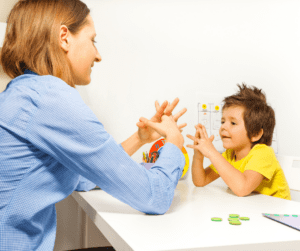Autism Spectrum Disorder (ASD) affects individuals of all ages. Although each person experiences ASD diagnosis differently, studies have shown that the earlier intervention begins, the better. Applied Behavior Analysis (ABA) therapy is one of many ways practitioners address challenges and reduce their impact on the daily lives of their clients with ASD. Both the timing and intensity of ABA therapy-based interventions have been proven by researchers to improve outcomes for individuals with ASD. So, how do you know what the most effective age is to start an ABA therapy plan for your child?
Diagnosis

It’s unlikely that any child will receive an ASD diagnosis before roughly age 2. Professionals typically don’t diagnose ASD earlier than 2 in order to ensure that there is a consistent pattern and history of behaviors that aligns with the diagnostic criteria from the CDC. From there, children that do receive an ASD diagnosis can start receiving services right away. This process usually begins with assessments of their current adaptive functioning levels compared to other children in their age group, such as the Verbal Behavior Milestones Assessment and Placement Program (VB-MAPP) and the Assessment of Basic Language and Learning Skills (ABLLS-R).
Early Intervention Counts

ABA intervention can help individuals with ASD develop new skills to enhance their independence at any age,
but the intensity of treatment significantly impacts ABA effectiveness. Particularly for early learners (ages 2-7), research suggests that higher treatment hours result in greater benefits. Research also shows that with early learners, rates of skill acquisition are strongly interconnected with the intensity of the therapy.
The structured approach of ABA therapy aligns well with the needs of individuals with ASD, creating a space where children can effectively develop the skills they need to succeed.
Early intervention ABA programs like Early Intensive Behavior Interventions (EIBI) and the Early Start Denver Model (ESDM) target children ages 2-4 and typically involve 20 to 40 hours of intervention services per week. For this young age group, the focus is on individualized programming and age-appropriate curriculum. Early intervention models like EIBI and EDSM have both demonstrated positive outcomes for early learners.
Treatment for Older Learners

For older learners (ages 7+), beneficial results can come from even shorter weekly hours. A focused model with fewer hours allows kids to engage more in outside activities and develop practical safety, social, and life skills. Research also suggests that older learners have more opportunities to apply the skills learned in therapy to real-world settings, like school, sports and activities, and their community.
ABA Graduation
Graduation from ABA therapy services may occur when a child has developed the skills they need to succeed in the world. This may look like reaching “normal” functioning levels of skills, relative to other children within their age group. However, some individuals may need or want additional support later in life, which can lead to reinitiating ABA therapy to address their ever-evolving needs.
Individuals with ASD of all age groups can benefit from effective ABA therapy tailored to their specific needs and developmental stage. Whether receiving 40 hours a week of intensive intervention for language, socialization, and adaptive skills, or a lower intensity intervention focusing on specific life skills, individuals can enhance their ability to navigate the world independently through individualized ABA therapy.
